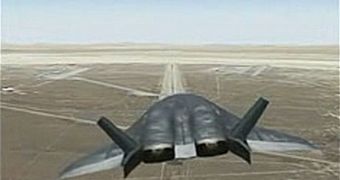Officials at the US Defense Advanced Research Projects Agency (DARPA) announce plans to carry out a new test flight of an unmanned bomber, the Falcon Hypersonic Technology Vehicle 2 (HTV-2).
The design calls for the creation of a spacecraft/aircraft platform that is capable of using scramjet technology to travel at speeds of up to Mach 20, and achieve global strike capabilities. The bomber would travel a lot faster than anything the enemy can throw at it.
Mach 20 means that the Falcon will be traveling at around 6,805.8 meters per second (6.8 kilometers per second). DARPA has been trying to construct this vehicle for quite some time now, but a previous attempt at a test flight failed.
The HTV-2 will be launched aboard a Minotaur 4 delivery system, from the Space Launch Complex-8 (SLC-8) at the Vandenberg Air Force Base (VAFB), in California. Originally, the spacecraft was supposed to launch yesterday, but bad weather delayed the attempt.
Launch is currently scheduled to take place between 7 am and 1 pm PDT (10 am to 4 pm EDT). At first, the HTV-2 is sent to space, and then it reenters the atmosphere, igniting its scramjet engines in the process. Only after this is done can the spacecraft achieve Mach 20.
During such a high-speed flight, the surface of the Falcon will reach temperatures exceeding 3,500 degrees Fahrenheit, more than what the American space shuttles endured when returning to Earth.
A basic calculation shows that a speed of 13,000 miles per hour will enable the vehicle to cover the distance separating New York from Los Angeles in less than 12 minutes. This is precisely why DARPA wants such a platform.
Within an hour of launch, the vehicle could strike literally any target on the surface of the planet. There are no intercontinental ballistic missiles (ICBM), airplanes or other military systems that will be able to rival it in speed.
“DARPA looks forward to conquering more unknowns about long-duration hypersonic missions. We need to increase our technical knowledge to support future hypersonic technology development,” DARPA Tactical Technology Office director Dave Neyland explains.
“We gained valuable data from the first flight, made some adjustments based on the findings of an engineering review board to improve this second flight, and now we’re ready to put all of that to the test,” adds the official, quoted by Space.
However, if HTV-2 fails, then DARPA will abort the project, since it has no further funds or plans to build a third Falcon. This is why tensions are high at Mission Control, in anticipation of this afternoon's launch.

 14 DAY TRIAL //
14 DAY TRIAL //